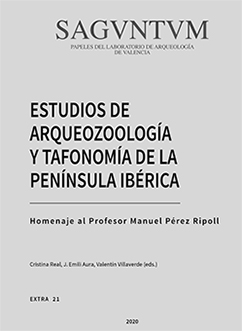Measurements of bones of seven female Barrosãs and one male barrosão (Boy Taurus L. 1758): a baseline for zooarchaeologists with notes on the evolution of Portuguese aurochsen and cattle
 Resumen
Resumen
Measurements of the bones of 7? and 1? Barros. cattle from Portugal are presented. These may serve as a baseline for osteometrical studies of Bos in Iberia. Sexual dimorphism varies: shaft width measurements show considerable dimorphism while those of the M3 and metapodial lengths show little. An osteometrical survey of late Pleistocene to modern Portuguese Bos reveals Pleistocene-Holocene (Magdalenian-Early Mesolithic) size reduction that accords with Bergmann’s rule. During the Mesolithic aurochsen dwarfed slightly possibly due to overhunting. Some large Chalcolithic Bos, probably aurochsen, had increased in size after the Mesolithic. Neolithic to Muslim period Bos were smaller and probably therefore domestic. Predator pressure relaxed during the Neolithic with the arrival of domesticated livestock allowing aurochsen to recover some of their former size – a scenario with parallels in the Near East and Denmark. After the reconquista, cattle increased in size. Modern Barros. are even more robust – reflecting selection for meat and power.
 Descargas
Descargas
Descargas
Publicado
Cómo citar
-
Resumen375
-
PDF 235
Número
Sección
Licencia

Este obra está bajo una licencia de Creative Commons Reconocimiento-NoComercial-SinObraDerivada 4.0 Internacional.
Con la publicación impresa de los trabajos, los/as autores/as aceptan que el Departament de Prehistòria, Arqueologia i Història Antiga de la Universitat de València pueda permitir la difusión y el libre acceso a través de las direcciones electrónicas y enlaces del editor/a.
El contenido de los trabajos es responsabilidad de los/as autores firmantes y no expresa la posición ni la opinión del Consejo de Redacción.
Las obras que se publican en esta revista están sujetas a los siguientes términos:
1. La revista conserva los derechos patrimoniales (copyright) de las obras publicadas, y favorece y permite la reutilización de las mismas bajo la licencia indicada en el punto 2.
2. Las obras se publican en la edición electrónica de la revista bajo una licencia Creative Commons Reconocimiento-NoComercial-SinObraDerivada 3.0 España (texto legal). Se pueden copiar, usar, difundir, transmitir y exponer públicamente, siempre que se cite la autoría, la url, y la revista, y no se usen para fines comerciales.
3. Los/as autores/as están de acuerdo con la licencia de uso utilizada por la revista, con las condiciones de auto-archivo y con la política de acceso abierto.
4. En caso de reutilización de las obras publicadas debe mencionarse la existencia y especificaciones de la licencia de uso además de mencionar la autoría y fuente original de su publicación.



